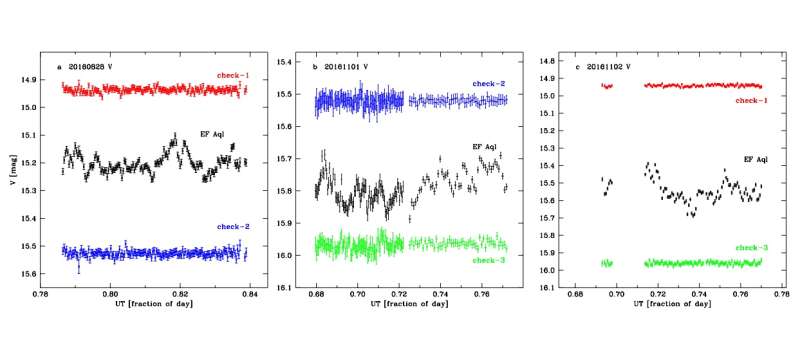March 1, 2017 report
Astronomers detect flickering from the star EF Aquilae

(Phys.org)—European researchers have detected optical flickering from a distant symbiotic star known as EF Aquilae (EF Aql for short). The new findings, presented Feb. 27 on the arXiv pre-print server, offer important hints on the nature and composition of this binary star.
Located about 11,000 light years away from the Earth, EF Aql is a symbiotic star, a member of the symbiotic Mira subgroup. Symbiotic stars are long-period interacting binaries consisting of an evolved giant transferring mass to a hot compact object – usually a late-sequence red giant providing material to a white dwarf. Although EF Aql was identified as a variable star in 1925, it was confirmed as a symbiotic star in 2016. However, this star has not been thoroughly studied yet, and its nature is still poorly understood.
To gain more insights about EF Aql, a team of astronomers led by Radoslav Zamanov of the National Astronomical Observatory (NAO) Rozhen in Bulgaria has recently carried out a series of CCD photometric observations of this star. For this job, they employed five telescopes equipped with CCD cameras between August and November 2016—four located in Bulgaria and one in Spain.
These photometric observations allowed the researchers to detect rapid aperiodic brightness variations, like the flickering seen from cataclysmic variables.
"Our observations in Johnson V and B bands clearly show the presence of stochastic light variations with an amplitude of about 0.2 mag on a time scale of minutes," the team wrote in the paper.
Such flickering in the form of stochastic photometric variations on timescales of a few minutes with amplitude of a few 0.1 magnitudes is typical for accreting white dwarfs in cataclysmic variables and recurrent novae. Therefore, it strongly indicates that the hot component in the studied symbiotic star is, indeed, a white dwarf.
"The presence of flickering strongly suggests that the hot component is a white dwarf," the paper reads.
The researchers estimated that EF Aql's mass loss rate is about 2 millionths of the mass of the sun year-1, which means that the white dwarf is capturing less than 1 percent of red giant's stellar wind.
"Estimates of the mass accretion rate onto the white dwarf and the mass loss rate in the wind of the Mira secondary star lead to the conclusion that less than 1 percent of the wind is captured by the white dwarf," the scientists concluded.
The research adds EF Aql to the currently very short list of symbiotic stars with detected optical flickering. Although there are more than 200 symbiotic stars known to date, only 10 of them show flickering activity, namely: RS Oph, T CrB, MWC 560, Z And, V2116 Oph, CH Cyg, RT Cru,o Cet, V407 Cyg, and V648 Car. The team also noted that the flickering source in EF Aql is similar to the flickering source in T CrB and RS Oph, which also contain a red giant mass donor.
More information: Discovery of optical flickering from the symbiotic star EF Aquilae, arXiv:1702.08243 [astro-ph.SR] arxiv.org/abs/1702.08243
Abstract
We report optical CCD photometry of the recently identified symbiotic star EF Aql. Our observations in Johnson V and B bands clearly show the presence of stochastic light variations with an amplitude of about 0.2 mag on a time scale of minutes. The observations point toward a white dwarf (WD) as the hot component in the system. It is the 11-th object among more than 200 symbiotic stars known with detected optical flickering. Estimates of the mass accretion rate onto the WD and the mass loss rate in the wind of the Mira secondary star lead to the conclusion that less than 1 per cent of the wind is captured by the WD. Eight further candidates for the detection of flickering in similar systems are suggested.
© 2017 Phys.org





















